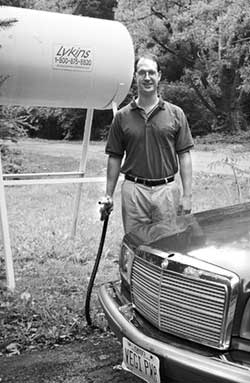                     |
|
Eric
Lang’s energy source—
Would you like fries with that?
 |
|
Eric Lang
|
In the film Back to
the Future, the nutty professor appeared ludicrous, fueling his time machine
automobile with beer and banana peels. But don’t underestimate the
power of suggestion. Recycled french fry grease now powers at least one
car here in Yellow Springs.
Bio-diesel, the renewable diesel fuel made from vegetable oils, is difficult
to find at commercial gas stations. That is why local engineer Eric Lang
keeps an elevated white fuel drum in the front yard of his Talus Drive
residence, filled to the brim with enough bio-diesel to last him about
four months.
“The stuff’s so clean you could probably eat it, though it wouldn’t
taste very good,” Lang said.
Supporting renewable energy sources that do not pollute the environment
has long been a passion for Lang. He remembers going through the first
oil crisis as a kid in Oregon, where gasoline was rationed by even and
odd numbered license plates. Drivers were so eager to be eligible for
gas that license plate theft became commonplace.
“It was only a temporary problem, but even then it was out of control,”
he said. “That’s when I first realized that we needed to find
an alternative to fossil fuels or we’d end up killing each other
for the last drop of oil.”
The fuel that Lang uses comes from Griffin Industries in Cincinnati. The
company gathers used biodegradable oil from restaurants, mostly soybean
oil, and converts it to diesel fuel. The diesel comes in varying shades
of mustard yellow, depending on how dirty the recycled oil was when they
received it.
At $2.20 a gallon, including home delivery, the environmentally responsible
fuel source has many benefits. Burning natural oil releases hydrocarbons
previously trapped in the earth, a process thought to be largely responsible
for the increased threat of global warming. By using soybean oil for fuel,
the gases that are released are the same ones that have been taken out
of the environment to grow the soybeans. No new carbon dioxide has been
added to the system, according to Lang.
“It’s a cycle versus a one-way street,” he said. “Bio-diesel
reduces almost all air exhaust pollution relative to regular diesel.”
Bio-diesel can be made from soybeans and algae, both of which, unlike
fossil fuels and crude oil, provide a renewable source of energy. Bio-diesel
gets as many if not more gallons per mile as regular diesel, said Lang.
And it has greater lubricating properties, therefore, it is better for
the car’s engine. Most modern European and American cars, buses,
and farm equipment will have no trouble handling bio-diesel, he said.
Lang hopes to generate interest in bio-diesel for the fleet of local school
buses and fire engines that fill up at the Yellow Springs diesel depot
at the high school. The local station could use a blend called B20, made
of 20 percent bio-diesel and 80 percent petrol. Bio-diesel is nontoxic,
biodegradable, and safer than regular fuel because it is nonflammable.
“It would be educational for the kids, and it would be a significant
step toward using an alternative fuel source for all vehicles,” Lang
said.
Lang sees himself not as an active environmentalist but more as a person
who supports sustainability. He is less interested in trying to limit
people’s actions and more in to looking for workable compromises
that allow humans to coexist with the environment.
However, the relative inactivity of the tired brown 1983 Mercedes sitting
in his driveway testifies that he does do his part in trying to reduce
waste and pollution.
“It had nearly 180,000 miles on it when I bought the car, and I figure
I’ve got a couple more decades on it,” Lang said. “As much
as I drive, I like to tell people, the car will last longer than fossil
fuels,” he said with a laugh.
His commitment to ecological, economical, and socially equitable ideals
gave Lang the name of his consulting company, E3 Designs. He is currently
leading a group with the National Renewable Energy Laboratory to license
a large utility wind turbine design that would lower the cost of wind
energy in cents per kilowatt hour.
Lang is also starting to showcase a new design for fiberglass manufacturing
that would cut down on styrene emissions, one of the globe’s top
ten polluters. These projects have been in the works for about seven years,
and they are only now being recognized.
“I’m so used to having to try and convince buyers of the economic
and utility benefits of my designs,” Lang said. “It’s pretty
satisfying to finally have companies shopping around and coming to me
with interest.”
Patience and diligence are just beginning to reap their rewards. But there
is still a lot of work to be done.
“There are other projects I’m interested in, but it’s harvest
time right now,” he said. “It’ll take another ten years
to see these projects through and implement them to really make a difference.”
Everyone can make an effort toward creating a sustainable world and Lang
believes that bio-diesel is a very reasonable way for local citizens to
contribute.
“People ask me, ‘What’s the problem with this?’ And
I say absolutely nothing, you should just do it!”
—Lauren
Heaton
|



